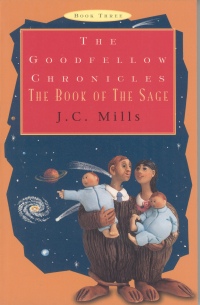| ________________
CM . . .
. Volume XI Number 8 . . . . December 10, 2004
excerpt: Sam looked at Edgar with eyes that had pooled with tears eyes that Edgar Goodfellow had known for more than seventy-five years and slowly nodded his head. And even though the face that framed them had weathered and wrinkled with the passage of time, Sam's eyes still held the same light that they always had. It was the light that Mr. Goodfellow had seen in his nephew's eyes, too; the light that had bound the two friends in a Sacred Seal that had almost spanned a lifetime. The Book of the Sage is the final chapter of "The Goodfellow Chronicles," a three-book series by artist and writer J.C. Mills that includes Book I: The Sacred Seal and Book II: The Messengers. This book, like the earlier titles, develops a conflict of world-threatening proportions, based on an ancient enmity between The Sage and The Fen. The characters will be familiar, although cast seventy-five years into the future. So, when we again meet Sam Middleton in Book III, he is well into his eighties. He has married India Jaffrey and is mourning the disappearance of her brother and his old friend Fletcher. He also has a young granddaughter named Alice, who, as we will learn, shares his unique ability to see and communicate with the creatures called The Sage. The clan of tiny Goodfellows will also be familiar: Jolly Goodfellow and Beatrice, Uncle Filbert, Edgar and Charlotte and other members of the Sage family introduced in previous books. We learn more about the evil Fen and their motivation to destroy The Sage and all things good in the world when we are re-introduced to the arch villain, Shrike. Unlike the alien setting of the second novel, and the historical contexts of the first novel, this book is set in the not-too-distant future and occurs within the domestic milieu both of the human and non-human characters alike. The plot is established by the need to solve the mystery of an alien artifact retrieved from Mars, an artifact that threatens the peaceful existence of The Sage and hence threatens the decline of the human race. The artifact holds the secret of the relationship between The Sage, wise and visionary creatures, and The Fen, grasping, cruel creatures of darkness. Mills has hinted at this relationship in previous books when she describes the knobby protrusions on the shoulder blades of the Sage. Like the previous titles in the series, The Book of the Sage is a quiet, predictable adventure fantasy. However, the appeal of the adventure and fantasy elements may be undermined by the portrayal of its chief protagonists. It is unlikely that children reading this book will identify with any of the main characters as Sam is now an old man, Edgar is clearly an adult Sage, and although we meet Alice, a girl of about thirteen, in chapter three, she does not enter the narrative in earnest until two-thirds of way through the novel. The jump to another time, two entire generations, might be a bit jarring for readers of the previous books in which the characters age only by a couple of years. The motivation of the Sage characters has also shifted. Readers learn more about their everyday lives and do not see them in action as advisors to important humans. Young female readers of this series, likely its biggest fans, might be moved by the quiet domesticity of the setting. And much of the plot advances around the need to rescue and nurture younger members of both The Sage and The Fen clans. In fact, the female characters in this book do little more than nurture others. This title is recommended to committed readers of "The Goodfellow Chronicles." The third book does not stand by itself as readers need to know about Sam's adventures as a child in the first two books to care about his adventures in this story as an old man. Recommended with Reservations. Paulette Rothbauer is an assistant professor in the Faculty of Information Studies at the University of Toronto where she teaches courses in children's and young adult literature and youth services librarianship.
To comment
on this title or this review, send mail to cm@umanitoba.ca.
Copyright © the Manitoba Library Association. Reproduction for personal
use is permitted only if this copyright notice is maintained. Any
other reproduction is prohibited without permission.
NEXT REVIEW |TABLE OF CONTENTS FOR THIS ISSUE
- December 10, 2004.
AUTHORS
| TITLES | MEDIA REVIEWS
| PROFILES
| BACK ISSUES
| SEARCH | CMARCHIVE
| HOME |
